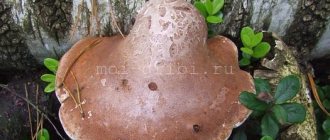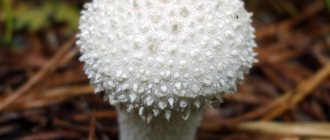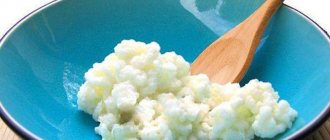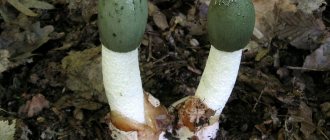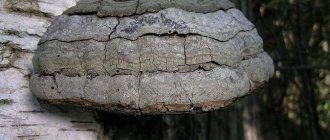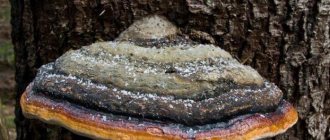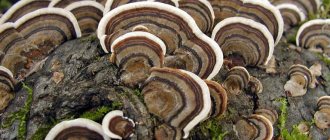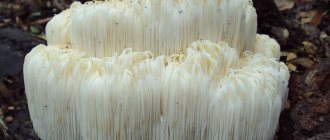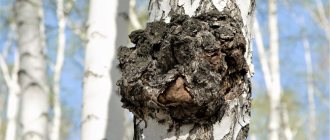Tree Root Dweller
The ram mushroom is a curious tree dweller, a representative of the large family of tinder fungi. Its name apparently comes from its superficial resemblance to the curls of mutton's wool. In fact, this is the name given to three different types of mushrooms – Grifola curly, Grifola Umbrella and Sparassis curly, despite the fact that all three species belong to different genera and families.
Appearance
The ram mushroom looks very fancy. Multiple stems are attached to a short base, which are intertwined in the most mysterious ways, and at their ends there are numerous caps. Their shape can be either round or oval, in the form of a hemisphere.
The caps are white below and grayish-beige above. This organism has several names. Scientifically, it is called griffola curly, and among the people it is sometimes called ram's head mushroom, meitake mushroom, or kvochka mushroom.
This mushroom, as a rule, grows in oak forests, where it feels at ease, as comfortable as possible, and therefore multiplies quickly. It is much less common in maple plantings, and even more so in chestnut or linden.
Grifola grows in hard-to-reach places, so it is not easy to find it, as it is often hidden in the roots of fruit trees. You can often find it under apricots, plums, and peaches. Very often, mushroom pickers pass by the meitake without noticing, since it has the ability to camouflage itself well into the terrain.
The mushroom blends in with the color of fallen leaves, which is why it is so difficult to notice. It is very popular in China because it is an integral part of folk medicine there. And since curly griffola is a rare species, in China it is grown in orchards specially created for this purpose.
Features of the umbrella mushroom, edible and poisonous
Grifola Curly Grifola Frondosa
Edible mushroom from the genus Grifola, family Fomitopsis. It is this species that most often bears the popular name Ram Mushroom, Ram Head, Ram Mushroom and even Drum. This species is also called the Leafy Polypore, Dancing Mushroom and Maitake. Like all tinder fungi, this species is a parasitic fungus that lives on diseased or already decaying wood and causes white rot of the trunk of the host tree. The mushroom contains substances that can be used to create anti-inflammatory and pain-relieving drugs.
Appearance
Grifola curly looks like a dense and bushy clump of pseudocap mushrooms with distinct, lighter colored stalks, turning into leaf-shaped or tongue-shaped caps, darker at the edges and lighter in the center. Fruit bodies reach a diameter of up to 80 cm and a weight of up to 10 kg. Individual caps reach a diameter of up to 5 cm with a radially wrinkled, rough surface. Depending on the age of the fruiting body and lighting conditions, the color range varies from greenish-gray to gray-pink.
The hymenophore, tubular type, is located on the underside of the caps and the upper part of the legs. The tubes are finely porous and white. Spore powder is white.
The pulp is brittle and white, with a pleasant taste and smell, reminiscent of a nut.
Where and when does it grow
It grows from late June to October on the stumps of broad-leaved trees - maples, oaks and lindens. Sometimes found on living trees in the lower part of trunks. Very rare.
Culinary use
The mushroom is completely edible, although not everyone likes its peculiar nutty flavor. It is successfully marinated, boiled in soup, fried and stewed. It is especially good when stewed with sour cream. However, there are serious obstacles to culinary experiments with this mushroom.
Protected by the state
Grifola Curly is listed in the Red Book of the Russian Federation as a rare, endangered species. Therefore, collecting and using this mushroom for food is extremely undesirable.
Benefits of Grifola curly
The benefits of Grifola curly have been known for a long time. Firstly, this mushroom is valued for its excellent immunostimulating effect. Secondly, in terms of the number of useful components, this specimen is extremely valuable. Third, maitake can provide significant cardiovascular support. And this mushroom contains substances that have a caring effect on the walls of blood vessels, cleanse the blood of cholesterol and normalize blood flow in general.
Based on this substance, many medications with a bactericidal effect are prepared. In addition, medicines and decoctions for tuberculosis have long been prepared from mushroom powder. With regular use, curly griffol helps improve the functioning of the nervous system, fights severe headaches, and saves from chronic fatigue and chronic overwork.
Grifola can have a beneficial effect in the treatment of problems in the oncological field. It is an excellent additional remedy that neutralizes the side effects of chemotherapy and prevents the formation of metastases. This product is also an excellent cancer prevention product.
The maitake mushroom has proven itself to be excellent in cleansing the body of toxins and waste. It has a positive effect on the condition of the skin:
- restores elasticity and firmness;
- removes greasy shine;
- cleanses pores;
- evens out the tone.
Grifola Umbrella Polyporus Umbellatus
A mushroom from the genus Polyporus, family Polyporaceae, also known as Umbrella polypore and Branched polypore.
Appearance
The fruiting body consists of many individual cap-peduncle bodies fused at the bottom. Fungi form settlements within which up to two hundred individual specimens can grow.
The hat has a slightly wavy surface, with a small depression in the center, and is painted in gray shades. Some specimens have small scales on their caps.
The hymenophore is tubular, the tubes are short and small, white or yellowish in color, extending far down the stalk. Spore powder is white or cream.
The leg is soft and thin, fused with other legs into a single cylindrical base.
The pulp is dense and white, with a pleasant taste and aroma reminiscent of dill.
Where and when does it grow
Grows from July to early November on tree roots, stumps and rotting forest floor. Sometimes it can grow on trunks high above the ground. Prefers deciduous trees - linden, maple and oak. It is very rare, but has been seen in Russia, Western Europe and North America.
Culinary use
An edible and very tasty mushroom, with delicate pulp and a pleasant smell, but only young fruiting bodies are suitable for food - in older ones, the taste and smell change greatly for the worse.
Eating grifola
There are certain restrictions on the consumption of sheep mushrooms. If you overeat prepared mushrooms, they are poorly digested, and you can get heaviness in the stomach and diarrhea. So it would be nice to limit the use of this mushroom not only for adults, but also for young children.
Many people consider the sheep's head mushroom to be inedible, but this is not at all true. It has a pleasant taste with nutty and creamy notes. It must be taken into account that only young mushrooms can be used in cooking, since adult, darkened specimens may have a bitter aftertaste.
In Southeast Asia, griffola curly is often eaten in pickled form, for which it is specially grown on plantations. The taste of such a mushroom is very specific and, out of habit, the person who decides to try it may not like it. Therefore, it is better to stew these mushrooms, and it is best to do this in a creamy sauce with a little spice.
Sparassis Curly Sparassis Crispa
A mushroom from the genus Sparassis, family Sparasaceae, also known as Mushroom Cabbage and Dryagel Curly. It grows on tree roots and causes red rot of wood. This species contains sparassol, which prevents the development of mold fungi, as well as substances with antitumor and antimicrobial activity.
Appearance
The fruiting body has the shape of a bush, spherical or irregularly spherical, weighing up to 10 kg, height up to 20 and diameter up to 60 cm. Sometimes larger specimens are also found. The mushroom consists of a short, thick central stalk, from which separate flat branches-blades up to 3 cm wide and up to 0.8 cm thick diverge in all directions. Their edges are wavy and, often, dissected. Externally, the mushroom resembles a giant head of cauliflower. At a young age, the fruiting body is whitish, then it gradually turns yellow, starting from the edges of the blades, until it becomes ocher-brown.
The hymenophore is located on the inner plane of the lobes and has a whitish-cream or grayish color. May feel rough to the touch. The color of the spore powder varies from whitish and yellowish to orange-ocher.
The stem of the fruiting body is up to 5 cm thick and up to 13 cm long, but is usually deeply buried in the soil and hardly noticeable. It also changes color as it ages, from whitish-yellowish to brownish and almost black.
The pulp is dense and white, brittle in young fruiting bodies. It has a pleasant taste and smell, reminiscent of a nut.
Where and when does it grow
It grows from late July to October on the roots, at the base of trunks, sometimes on the stumps of coniferous trees - most often pine, but also larch, spruce, fir and cedar, in old coniferous and coniferous-deciduous forests. The fruiting bodies are connected by strands of mycelium to the diseased root of the tree and cause red-brown rot of the roots and base of the trunk. In the final stage of development, rotten wood cracks, and clusters of mycelium are visible in the cracks.
The species is found mainly in the northern and eastern regions of Russia.
Similar view
Sparassis curly is similar to the even rarer Sparassis lamellar, which parasitizes oak trunks, but this species is colored straw-yellow, and its blades are denser and rougher.
Culinary use
The mushroom is edible, has an excellent taste and is suitable for making soups, drying and frying. However, only young fruiting bodies – white or slightly yellowish in color – are suitable for food. Old, brown, become too hard and can no longer be used for food.
Protected by the state
This mushroom is listed in the Red Book of Russia as a rare endangered species, so collecting it for food purposes is not recommended.
Medicinal properties of ram mushrooms
The medicinal properties of ram mushrooms are known to many. In China, griffola curly is currently cultivated on an industrial scale as a medicinal plant. To do this, entire “hordes” of maitake are created on fruit trees, specially populated with mushrooms. When the mushrooms ripen, an extract is made from them. It is additionally purified from possible harmful impurities. The average yield is 1 kilogram of extract per 10 kilograms of fresh product.
Why is the extract made specifically? Scientists have come to the conclusion that this particular product exhibits the greatest number of positive properties of this mushroom. It is worth knowing that its capabilities are enormous. The mushroom helps in the fight against a variety of health problems.
So, the ram mushroom has medicinal properties, which are:
- improve glucose and insulin metabolism;
- provide prevention of heart and vascular diseases due to the removal of cholesterol;
- increase the elasticity of the walls of blood vessels;
- reduce blood pressure;
- strengthen immune functions, especially in the fight against cancer;
- minimize the negative manifestations of menopause, helping women normalize their own condition even in such a difficult period;
- normalize metabolic processes and hormonal levels in order to normalize and maintain weight at an optimal level;
- fight viral diseases, generating healthy cells;
- fight liver diseases, including cirrhosis;
- reduce or eliminate discomfort during and before menstruation.
In other words, the benefits of the extract are clear to everyone. It normalizes the functioning of the endocrine systems, heart, blood vessels, helps with liver diseases caused by toxins or viruses, and eliminates fungal infections. The healing power of the ram mushroom has been proven by specialists of modern medicine.
In folk medicine, extracts, decoctions and infusions are actively used. Honey extract of the ram mushroom is also used in cosmetology. In particular, this product is often included in cosmetics, helping to restore the beauty and health of the skin.
Recipes
Below are several recipes for lamb mushroom dishes.
Mushroom soup
Required:
- Lamb mushroom – 300g.
- Potatoes – 7 pcs.
- Onions – 1 pc.
- Carrots – 1 pc.
- Chicken egg – 2 pcs.
- Flour – 1 tbsp.
- Vegetable oil – 2 tbsp. spoons.
- Salt, pepper and herbs - to taste.
Cooking:
- Knead the pasta dough from flour, eggs and salt, then divide it into strips and dry on a cutting board.
- Boil the chopped fruit bodies for 20 minutes, then add vegetables, cut into small cubes, and cook for another half hour.
- Add pasta to the pan and cook for another 10 minutes. Before finishing cooking, add greens to the soup and pour in vegetable oil.
The dish is ready!
In sour cream with cheese
Required:
- Mushroom Ram – 200 gr.
- Butter – 40 gr.
- White wine – 60 ml.
- Sour cream – 180 gr.
- Cheese – 40 gr., hard varieties.
- Salt and pepper - to taste.
Cooking:
- Place the fruit bodies in a frying pan with melted butter and simmer for 10 minutes.
- Pour wine into the dish, stir and cook for another 5 minutes.
- A couple of minutes before it’s ready, add sour cream and cheese, grated on a medium grater, to the remaining ingredients.
- Mix everything thoroughly, close the lid and let the dish brew for 10 minutes.
The dish is ready!
Roast
Required:
- Mushroom Ram – 300 gr.
- Onion – 1 piece, medium size.
- Salt and pepper - to taste.
Cooking:
- Pour the fruit bodies with water and boil, after boiling, for 10 minutes.
- Fry the mushrooms and diced onions in oil in a frying pan for 30 minutes. At the end of the roasting process, add salt and pepper.
Preparing the tincture
Traditional medicine has given us many recipes. All of them have been tested over the years and have helped more than one person. Ram mushroom tincture helps in the fight against many diseases. It improves immunity and suppresses the development of tumors.
We recommend reading: “Mushroom Veselka”
It doesn't take much effort to prepare the tincture. You need to take 3 tablespoons of dried fruits, chop them and pour vodka. Place the sealed bottle in a dark and cool place and leave for 2 weeks. Afterwards, there is no need to strain the tincture; it should be consumed together with the resulting sediment.
Take 2-3 times a day 30-40 minutes before meals. One serving, depending on the severity of the disease, can range from one to three teaspoons of infusion.
Contraindications for use
The main contraindications include the following conditions:
- pregnancy and breastfeeding;
- tendency to anaphylactic reactions;
- frequent constipation, digestive problems and stomach diseases;
- kidney and liver failure;
- disturbance in the production and secretion of bile;
- low blood pressure and too slow heart rate;
- absence of spleen;
- weak intestinal microflora;
- age up to 12 years.
With such diseases, grifola can worsen the condition and cause intoxication.
If you follow the instructions for use, the ram mushroom will have only a positive effect on your health. But before you start taking it, you should definitely consult with a specialist about contraindications. Otherwise, you may encounter not very pleasant side effects.
Healing properties
There are legends about the healing properties of the lamb's head mushroom; since ancient times it has been used in folk medicine, not only in the east, in particular in China, but also in Rus'.
In the old days, powders were made from grifola, and with their help, folk healers even managed to treat such a terrible disease at that time as tuberculosis. And all because this mushroom has powerful bactericidal properties. Grifola cumulus is also rich in vitamins, high in fiber and amino acids.
The detailed chemical composition of the fungus has not yet been fully studied. Gradually, more and more useful properties are being discovered:
- At the moment, science knows for sure that griffola curly has a beneficial effect on the condition of the cardiovascular system.
- Thanks to other valuable properties of this gift of the forest, it is possible to reduce the content of harmful cholesterol in the blood, which is very important for patients with diabetes.
- Various decoctions and infusions are excellent for getting rid of headaches, improving sleep and reducing stress.
- The high content of antioxidants has a beneficial effect on the condition of human skin, the body is cleansed, the skin gets rid of various rashes, and the complexion improves.
In a word, a healing balm for our nervous system. It is also believed that meitake is quite capable of mitigating the effects of chemotherapy in the treatment of cancer.
This gift of nature must also be consumed by women. It has a positive effect on hormonal levels and metabolism during menopause, relieves menstrual pain, and lowers blood pressure.
